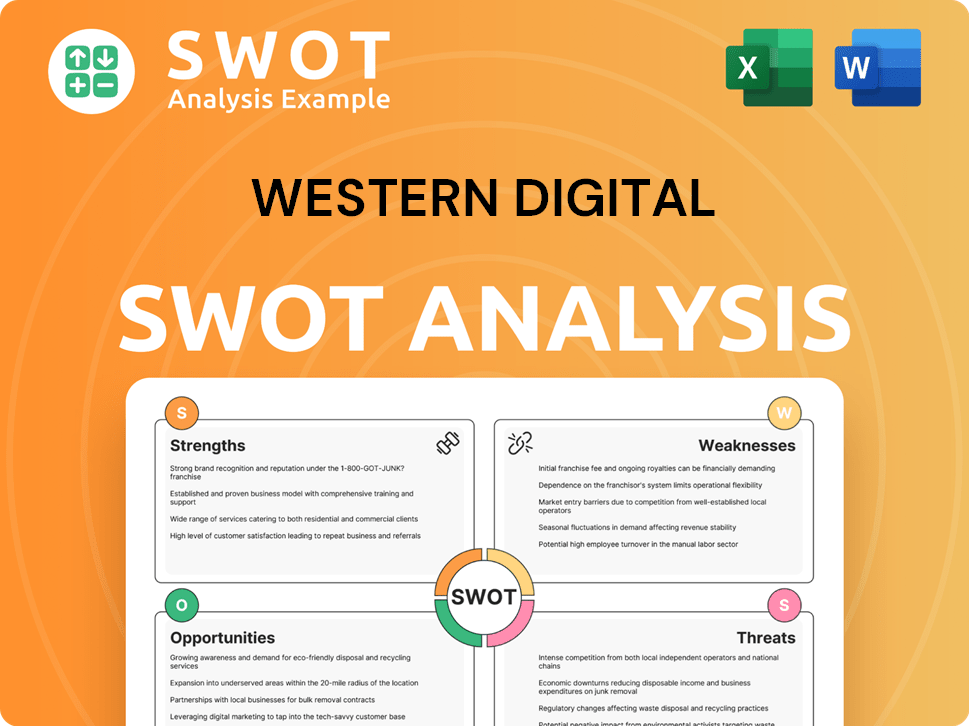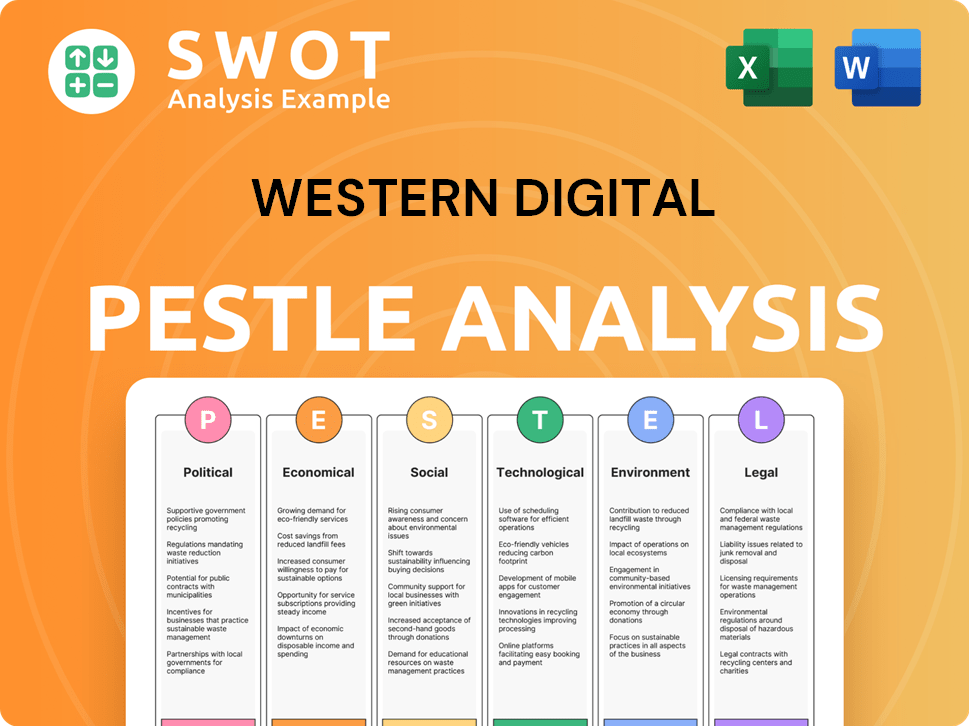Western Digital Bundle
Who Buys Data Storage? Unveiling Western Digital's Customer Base
In an era defined by data, understanding the "who" behind data storage is paramount, especially for industry giants like Western Digital. This exploration delves into Western Digital's Western Digital SWOT Analysis, examining its customer demographics and target market to reveal the key drivers of its success. From individual consumers to massive data centers, the landscape of data storage is diverse and ever-changing.

This analysis will dissect Western Digital's Customer Demographics and Target Market, offering insights into its Market Segmentation strategies. We'll uncover the Consumer Profile, exploring factors like Western Digital customer age demographics, Western Digital target market geographical location, and Western Digital customer income levels. By examining the Data Storage landscape, we aim to answer the question: Who are Western Digital's ideal customers, and how does the company adapt to their evolving needs?
Who Are Western Digital’s Main Customers?
Understanding the Customer Demographics and Target Market of Western Digital is crucial for grasping its market position and strategic direction. The company's customer base is segmented into distinct groups, each with unique needs and purchasing behaviors. This segmentation allows for targeted marketing and product development, optimizing resource allocation and enhancing customer satisfaction.
Western Digital operates in both B2B and B2C markets, serving a diverse range of customers. This article provides an overview of the primary customer segments, their characteristics, and their contribution to the company's revenue. Analyzing these segments provides insights into Western Digital's market dynamics and future growth opportunities.
The company's focus on data storage solutions positions it at the center of the digital economy. As data generation continues to grow exponentially, Western Digital aims to capture value across various market segments. For a deeper dive into Western Digital's strategic direction, consider reading about the Growth Strategy of Western Digital.
The Cloud segment is the largest revenue generator for Western Digital, primarily serving data centers and cloud-based storage solutions. This segment caters to hyperscale cloud providers, enterprise data centers, and OEMs. The demand for data storage in this segment is driven by the growth of AI applications and data lakes.
The Client segment includes HDDs and SSDs for desktops, laptops, and consumer electronics. This segment serves PC and laptop manufacturers. The anticipated end-of-life for Windows 10 in 2025 is expected to drive upgrades and increase demand for storage solutions.
The Consumer segment focuses on branded flash and removable storage products sold through retail channels. This segment targets individual consumers who require storage for personal use, mobile devices, and content creation. The consumer segment includes products like USB flash drives, microSD cards, and external storage hard drives.
The Cloud segment accounted for 87% of total revenue, approximately $2.0 billion, demonstrating a 38% year-over-year increase. The Client segment represented 6% of total revenue, or $137 million, experiencing a 2% sequential and year-over-year decrease. The Consumer segment accounted for 7% of total revenue, or $150 million, showing a 13% sequential and 4% year-over-year decline.
Western Digital's market segmentation strategy focuses on three primary segments: Cloud, Client, and Consumer. The company is strategically emphasizing its HDD technology, particularly in the cloud and enterprise markets, to capitalize on the increasing demand for data storage solutions.
- Cloud: Driven by hyperscale cloud providers and enterprise data centers.
- Client: Influenced by PC and laptop manufacturers, with upgrades anticipated due to the end-of-life of Windows 10.
- Consumer: Targets individual consumers, with demand influenced by personal use and content creation.
- Market Share Analysis: Western Digital competes with other major players in the data storage market, including Seagate and Samsung.
Western Digital SWOT Analysis
- Complete SWOT Breakdown
- Fully Customizable
- Editable in Excel & Word
- Professional Formatting
- Investor-Ready Format

What Do Western Digital’s Customers Want?
Understanding the customer needs and preferences is crucial for any company, and for Western Digital, this involves a deep dive into the requirements of its diverse customer base. The company's success hinges on its ability to provide reliable, high-performance, and scalable data storage solutions tailored to the specific needs of each segment. This approach allows Western Digital to maintain a competitive edge in a rapidly evolving market.
The primary drivers for Western Digital's customers vary significantly across its segments. For instance, cloud segment customers, including hyperscale cloud providers and enterprise data centers, prioritize capacity, total cost of ownership (TCO), and sustainability. Conversely, the Client and Consumer segments focus on factors like speed, reliability, ease of use, and compatibility. This differentiation necessitates a multifaceted approach to product development, marketing, and customer support.
The company's ability to adapt to changing market dynamics is critical. The Western Digital customer base is influenced by technological advancements and shifts in consumer behavior. The company's strategic focus on innovation and customer satisfaction is reflected in its product offerings and customer service initiatives.
Hyperscale cloud providers and enterprise data centers prioritize storage solutions that offer the highest capacity at the lowest cost per terabyte. They need to manage the exponential growth of data, which is expected to triple between 2023 and 2028. The demand for high-performance storage solutions is also increasing due to AI and machine learning technologies.
Customers in the Client and Consumer segments are influenced by speed, reliability, ease of use, and compatibility. This segment includes users of HDDs, SSDs, and embedded storage solutions. There has been a decline in these segments, indicating shifts in consumer preferences or market dynamics.
Western Digital is developing advanced technologies like Heat-Assisted Magnetic Recording (HAMR) and UltraSMR technology to meet customer needs. HAMR is currently being tested with major hyperscale customers. UltraSMR technology enables higher storage density.
The company offers a diverse product portfolio, including HDDs, SSDs, and embedded storage solutions. SSDs offer faster and more reliable storage for high-performance computing, while HDDs are primarily used for mass data storage. The product range caters to different performance and application needs.
Customer loyalty is fostered through product reliability and comprehensive technical support. Western Digital reported an 85% customer satisfaction rate in its fiscal year 2024 customer survey. The company offers customized storage solutions and rigorous product testing to maintain customer satisfaction.
Some customer feedback indicates challenges with portable hard drives requiring account creation and instances of warranty issues and product failures. This highlights areas for continuous improvement in customer experience and support. The company is always working to address customer concerns.
Understanding the Western Digital customer base involves analyzing various aspects, including their needs, preferences, and behaviors. This analysis helps the company tailor its products and services effectively. For a deeper dive into Western Digital's financial structure and business model, consider exploring the Revenue Streams & Business Model of Western Digital.
- Market Segmentation: The company segments its market into Cloud, Client, and Consumer categories, each with distinct needs.
- Product User Profile: Users of HDDs and SSDs have different priorities; HDDs for mass storage and SSDs for speed and reliability.
- Customer Purchase Behavior: Purchase decisions are influenced by factors like capacity, cost, speed, and reliability.
- Customer Demographics: The customer base includes hyperscale cloud providers, enterprise data centers, and individual consumers.
- Customer Needs and Wants: Customers want reliable, high-performance, and cost-effective storage solutions.
Western Digital PESTLE Analysis
- Covers All 6 PESTLE Categories
- No Research Needed – Save Hours of Work
- Built by Experts, Trusted by Consultants
- Instant Download, Ready to Use
- 100% Editable, Fully Customizable

Where does Western Digital operate?
The geographical market presence of Western Digital (WD) is extensive, reflecting its status as a global leader in data storage solutions. The company strategically positions itself to reach a diverse customer base worldwide. While specific breakdowns for 2024-2025 aren't fully detailed, WD's operations and partnerships indicate a broad international reach.
Western Digital's strategy includes adapting to the needs of rapidly evolving markets. Participation in events like GITEX Africa 2024 highlights its focus on expanding into and catering to the African market. This approach demonstrates a commitment to localizing offerings to succeed in diverse geographical areas.
The company's ability to offer a wide array of products and solutions supports its strong market position. The increasing demand for data storage solutions across various sectors globally allows Western Digital to capitalize on opportunities and reinforce its industry leadership. This is crucial for understanding the Western Digital target market.
Western Digital has a substantial global footprint, allowing it to serve customers worldwide. This extensive reach is crucial for its market segmentation strategies. The company's international presence supports its ability to meet the diverse needs of its customer demographics.
Western Digital actively targets emerging markets for growth. This includes regions experiencing rapid technological advancements and increasing data storage needs. The company's focus on these areas is key to its long-term success and understanding of the consumer profile.
Western Digital collaborates with cloud service providers and system integrators globally. These partnerships expand its market reach and enhance its ability to provide comprehensive data storage solutions. This approach supports its ability to understand Western Digital's customer needs and wants.
The company tailors its products and services to meet local market demands. This includes adapting offerings to specific regional preferences and applications. This localization strategy helps Western Digital succeed in diverse markets, which is vital for defining Western Digital's target audience.
Western Digital operates in key markets across North America, Europe, and Asia-Pacific. These regions represent significant revenue streams and growth opportunities. Understanding the geographical locations is essential for Western Digital's market share analysis.
- North America: A mature market with high demand for enterprise and consumer storage.
- Europe: Strong demand from both businesses and individual consumers.
- Asia-Pacific: Rapid growth driven by increasing digitalization and data consumption.
- Emerging Markets: Significant potential for expansion and innovation.
Western Digital Business Model Canvas
- Complete 9-Block Business Model Canvas
- Effortlessly Communicate Your Business Strategy
- Investor-Ready BMC Format
- 100% Editable and Customizable
- Clear and Structured Layout

How Does Western Digital Win & Keep Customers?
Acquiring and retaining customers is crucial for the success of any company, and for Western Digital, this involves a multi-faceted approach. The company leverages its strong brand reputation, diverse product portfolio, and commitment to innovation to attract and keep customers. Strategic partnerships, particularly in its B2B segments like Cloud and Enterprise, are a key element of their customer acquisition strategy.
For the B2B sectors, Western Digital collaborates with cloud providers, system integrators, and software developers to expand its market reach. This approach helps the company access new markets and customer segments, ultimately increasing its market share. The focus on providing solutions with a low total cost of ownership (TCO) and high scalability is also a strong acquisition driver, especially with the growing demand for AI and data-intensive applications. This is a critical factor in defining the Western Digital target market.
In the realm of marketing, while specific campaigns for 2024-2025 are not fully detailed, participation in industry events, such as Computex 2025 and GITEX Africa 2024, highlights direct engagement with businesses and professionals. Additionally, investor days, such as the Investor Day 2025, influence customer confidence by demonstrating long-term stability and innovation. Understanding the Western Digital customer purchase behavior is key to these strategies.
Western Digital partners with hyperscale cloud providers and system integrators. These partnerships help expand market reach and access new customer segments. This collaborative approach is vital for the company's growth within the data storage industry.
Delivering solutions with a low total cost of ownership (TCO) is a key acquisition driver. This is especially important for enterprise and cloud customers. It aligns with the growing demand for AI and data-intensive applications, influencing Western Digital's customer needs and wants.
Participation in events like Computex 2025 and GITEX Africa 2024 is a key marketing strategy. These events allow Western Digital to showcase its technologies and solutions directly to businesses and professionals. This approach is crucial for understanding Owners & Shareholders of Western Digital.
Investor Day 2025 communicates strategic vision and future prospects. This builds customer confidence by demonstrating long-term stability and innovation. This indirectly influences customer retention and helps define the Western Digital customer age demographics.
Customer retention at Western Digital is heavily reliant on product reliability and performance. The company emphasizes customer satisfaction, reporting an 85% satisfaction rate in fiscal year 2024. This involves providing comprehensive technical support and offering customized storage solutions to address specific customer requirements. Rigorous testing to ensure product reliability is also a key component. However, some customer reviews from late 2024 and early 2025 indicate challenges with customer service and software usability, highlighting areas for improvement in retention efforts. The planned separation of the Flash business, finalized in February 2025, is expected to streamline support processes, potentially impacting customer experience. This impacts Western Digital's market segmentation strategies.
Western Digital Porter's Five Forces Analysis
- Covers All 5 Competitive Forces in Detail
- Structured for Consultants, Students, and Founders
- 100% Editable in Microsoft Word & Excel
- Instant Digital Download – Use Immediately
- Compatible with Mac & PC – Fully Unlocked

Related Blogs
- What are Mission Vision & Core Values of Western Digital Company?
- What is Competitive Landscape of Western Digital Company?
- What is Growth Strategy and Future Prospects of Western Digital Company?
- How Does Western Digital Company Work?
- What is Sales and Marketing Strategy of Western Digital Company?
- What is Brief History of Western Digital Company?
- Who Owns Western Digital Company?
Disclaimer
All information, articles, and product details provided on this website are for general informational and educational purposes only. We do not claim any ownership over, nor do we intend to infringe upon, any trademarks, copyrights, logos, brand names, or other intellectual property mentioned or depicted on this site. Such intellectual property remains the property of its respective owners, and any references here are made solely for identification or informational purposes, without implying any affiliation, endorsement, or partnership.
We make no representations or warranties, express or implied, regarding the accuracy, completeness, or suitability of any content or products presented. Nothing on this website should be construed as legal, tax, investment, financial, medical, or other professional advice. In addition, no part of this site—including articles or product references—constitutes a solicitation, recommendation, endorsement, advertisement, or offer to buy or sell any securities, franchises, or other financial instruments, particularly in jurisdictions where such activity would be unlawful.
All content is of a general nature and may not address the specific circumstances of any individual or entity. It is not a substitute for professional advice or services. Any actions you take based on the information provided here are strictly at your own risk. You accept full responsibility for any decisions or outcomes arising from your use of this website and agree to release us from any liability in connection with your use of, or reliance upon, the content or products found herein.